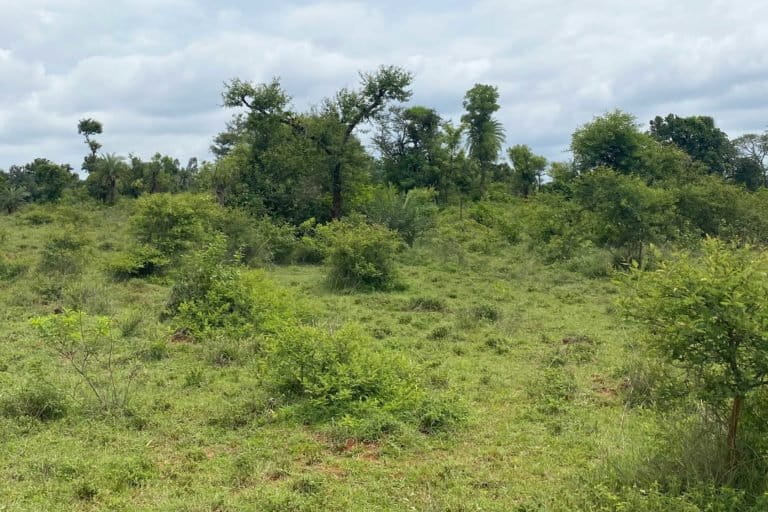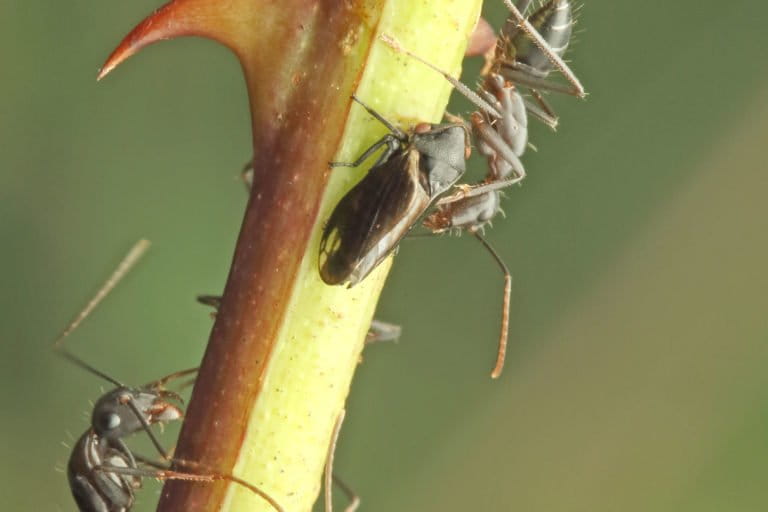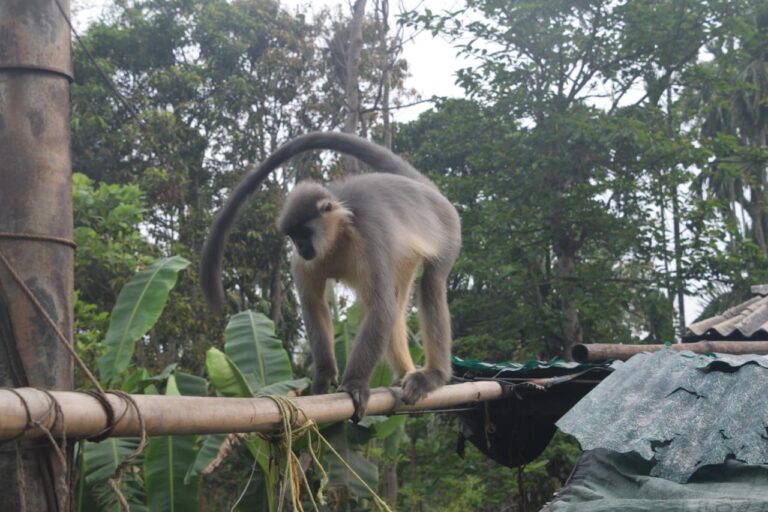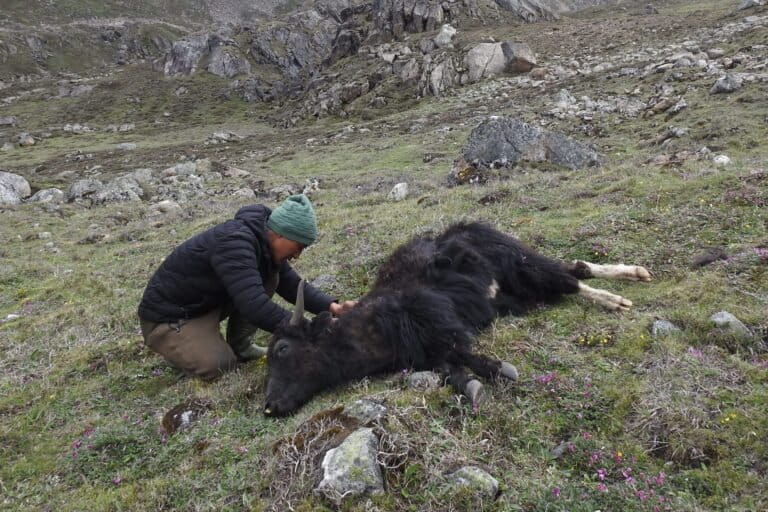- Entomologists have discovered three new leafhopper species from the genus Macropsis Lewis from Karnataka, Himachal Pradesh and Arunachal Pradesh.
- The species from Karnataka, found in Hesaraghatta on the outskirts of Bengaluru, shares a mutualistic relationship with ants where ants feed on sugary excretions of leafhoppers and in return they provide protection to leafhoppers.
- Hesaraghatta has been proposed for the construction of a film city and the new species may help in strengthening the case to conserve this biodiverse habitat.
During the monsoon season of 2011, H.M. Yeshwanth, a doctoral student studying insects, browsed the bushes of the thorny Acacia catechu plant in Hesaraghatta near Bengaluru, Karnataka and came across some black leafhoppers. Curiously enough, he noted that the bugs were closely associated with ants. He took photos of the bugs and collected a few to show his professor, C.A. Viraktamath, renowned insect taxonomist and former professor at the University of Agricultural Sciences in Bengaluru, who specialises in leafhoppers.
Later, Yeshwanth was surprised to learn that it was a new species. Over the next few years, two more new species from the same group as the one in Bengaluru were found in the northern state of Himachal Pradesh and Arunachal Pradesh in the northeast. All three species have been recently described in a paper published in the journal Zootaxa.
Leafhoppers are small, slender, sap-sucking insects whose hind legs are adapted for jumping. They belong to a diverse family called Cicadellidae and they are capable of flying. Some leafhoppers are found on specific host plants. In large numbers, they can damage plants and are capable of inflicting economic losses for some agricultural crops.

James N. Zahniser, an entomologist at the United States Department of Agriculture, who has described several species of leafhoppers said that leafhoppers play numerous roles in their ecosystems. These include “feeding on various plant species, falling prey to insectivorous birds and mammals, being hosts to parasitizing insects, cooperating with other species like ants, acting as vectors of bacterial and fungal plant pathogens, and serving as hosts to bacterial endosymbionts.”
Among insects, leafhoppers are generally understudied. This is in part because of their small size and high diversity, Zahniser said. “There are about 22,000 described species of leafhoppers, but estimates of their actual diversity are well above 100,000 species. There is much yet to discover about this interesting group of insects.”
Unique male reproductive structures
The leafhopper from Bengaluru was named Macropsis krishna, where ‘Krishna’ means black in Sanskrit. The other two species were discovered from the high-altitude towns of Dalhousie in Himachal Pradesh and Khonsa in Arunachal Pradesh. The former was named M. dalhousiensis while the latter was named M. puttarudriahi in honour of the renowned late entomologist of Karnataka, Dr. M. Puttarudriah.

“The species from Bengaluru, M. krishna, is shiny black while M. dalhousiensis is likely green in life and M. puttarudriahi is pale brownish yellow. M. dalhousiensis resembles two other Indian species, M. ganeshai and M. vagdeviae, but the structure of its male genitalia differs from that of M. ganeshai,” said Yeshwanth, who is now a research fellow and curator at the Department of Entomology at the University of Agricultural Sciences in Bengaluru. While M. puttarudriahi looks like M. dalhousiensis, its internal structures especially male genitalia differ from the other known species of the genus from India, he added.
“The new publication by Viraktamath and Yeshwanth continues on a history of excellence and high-quality publications by Dr. Viraktamath and his students and colleagues in documenting the leafhopper (Hemiptera: Cicadellidae) fauna of India and surrounding areas,” Zahniser said.
Mutualism with ants
M. krishna breeds on the Acacia catechu plant, which grows in the dry deciduous forests of Bengaluru. The populations of M. krishna start building up with the onset of southwest monsoon in May and they continue to breed till the end of August when the population disappears. Leafhoppers emerge again next May from eggs that have been laid by adults in the previous year.
“Ants are commonly associated with Acacia plants,” explained Zahniser. M. krishna shares a mutualistic relationship with Camponotus sp. ants. In an association known as ‘ant attendance’, ants feed on a sugary liquid excreted by the leafhopper and in return the ants provide protection to the leafhopper from predators and parasites. “It’s easy food for the ants,” said Yeshwanth. “The ants milk the hoppers for the droplet of the solution.”
“It is not uncommon for ants to ‘tend’ leafhoppers,” explained Zahniser. “These leafhoppers feed on phloem sap from the host plant, which is high in sugar content. The leafhopper excretions are often referred to as ‘honeydew’ and are also high in sugar, which the ants like.”
Insects and plants are associated and interlinked and if one of them is disturbed there would be an imbalance in the ecosystem, Yeshwanth said. For example, he explained, if the leafhoppers are gone, ants could be in trouble.
Habitat under threat
In recent years, reports from around the world have highlighted a decline in the abundance, species richness and range sizes of insects raising concerns on the possible effects on ecosystem functioning. Evidence suggests land-use change, climate change and agriculture among other stressors.
Grasslands host diverse species of butterflies, moths, ants, bees, wasps, beetles, crickets, grasshoppers, leafhoppers and seed bugs. But studies have mostly focused on butterflies and entomologists pointed out a lack of data on the other insect groups.

According to Yeshwanth, more insect species are likely to be found in Hesaraghatta on the outskirts of Bengaluru, which is a very biodiverse habitat. But, he adds, the “sad part is that the place is going to be destroyed for the construction of a film city on this land, which has been proposed by the Government.” Conservationists have been urging authorities to declare the grasslands of Hesaraghatta as a conservation reserve. The discovery of this new leafhopper species will help provide data to support efforts to save this place.
Yeshwanth frequently visits Hesaraghatta to collect interesting insects and plans to survey them further. “It comes with many surprises.”
CITATION:
Viraktamath C., & Yeshwanth H. (2021). Three new leafhopper species of Macropsis Lewis (Hemiptera: Cicadellidae: Eurymelinae: Macropsini) with a key to species from the Indian subcontinent. Zootaxa, 4903(3), 353-372.
Read more: How butterflies strike a relationship with ants using specialised organs














